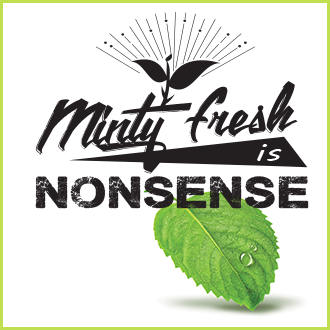


We are not Crazy: You may have a hard time accepting this, and we run the risk of being labeled as crazy conspiracy theorists wearing tin foil hats by telling you this, but here goes anyway.
Everyone wants to feel ‘minty fresh’ – Truth be told, few people could explain what those words really mean from an objective health standpoint. ‘Minty fresh’ is a phrase that describes little more than a sensation – an illusion provided by certain ingredients in toothpaste whose only function is to help you believe that something good just happened. In actual fact, some ‘minty fresh’ products actually contribute to causing more problems than they supposedly cure. In any event, feeling minty fresh certainly doesn’t mean you that have a clean mouth.
Bacteria Largely Unaffected: Bacteria, which are the primary cause of most oral disease, including bad breath, are largely unfazed by the effects of the $1.8 billion dollars’ worth of oral products sold to us purportedly to deliver that ‘minty fresh’ feeling. Fact is, true oral health and good breath comes from products and practices that minimize the numbers of acid producing bacteria in your mouth, and the colonies called plaque that they live in.
Best Weapon = Toothbrush: To that end, a toothbrush, or similar tool that allows the scraping of this plaque biofilm off of your mouth’s surfaces, is the first and most important tool in your arsenal of weapons against bad bacteria and the problems they cause. I’ll say that again. A toothbrush – not toothpaste, not tingly mouthwash, not even flossing (given that your tongue is the largest repository of oral bacteria in your mouth and you can’t really floss your tongue) is your most important tool to fighting bacterial plaque buildup on your teeth and gums.
But don’t simply accept our word for it: Here’s what the National Institute of Health has recently said about toothpaste (which they call dentifrice).
Dry Brushing: Ok – so what are you supposed to do then? Again, this may blow your mind a little, given that you’ve been indoctrinated about the indispensable value of toothpaste for over 100 years and counting, but sources such as the Journal of the American Dental Association, Registered Dental Hygienist Magazine, the International Association of Dental Research, among many others, all tout the advantages and benefits of…..wait for it…..Dry Brushing! (that news is gonna cost Colgate a lot of money someday soon).
Scrape a Dry Surface: Once you think about it, dry brushing actually makes total sense. Bacterial plaque is sticky. It’s like paint on a wall after a while. And no one I know wets a wall before trying to scrape the paint off of it. It’s completely counterintuitive, but that’s what toothpaste does – toothpaste wets the surface of your teeth making scraping the plaque off of them less effective.
Reduces Plaque and Bleeding:
In a study covering 4 years, data showed that using this dry brushing technique reduced plaque buildup by 63% and reduced bleeding by 55%.
A Second Coat: The research also suggested that following the dry brushing protocol with a quick second brushing using some form of toothpaste, also delivers additional benefits – depending on the toothpaste’s ingredients. That second brushing’s intent is not to remove plaque but rather to coat the teeth with beneficial substances – like fluoride for those who do not reside in fluoridated water areas – or, as we suggest, probiotic bacteria. Our recommendation therefore, for this second brushing is to use a probiotic toothpaste that leaves behind a coating of beneficial bacteria to further aid in denying the bad bacteria from having a place to easily re-inhabit on your mouth’s surfaces.

Actually Minty Fresh: Adhering to this new regimen may not make you ‘feel’ as minty fresh as you used to right away – but you will actually BE fresh, and have a cleaner mouth to boot!
BONUS TIP: We’ve discussed the importance of brushing relative to plaque control. But the other critical thing you need to keep in mind is this. Keeping your toothbrush clean between brushings can’t be over-emphasized, since it is full of freshly scrapped bacteria after each use. And here’s a related issue that most folks have never been told. Storing your recently cleaned toothbrush on your bathroom counter, within 6 feet of your toilet, is a dangerous habit, unless you always remember to CLOSE YOUR TOILET LID BEFORE YOU FLUSH. If you are in the habit of flushing your toilet with the lid open, you are exposing your toothbrush to a microscopic spray of fecal matter and urine that the flushing action aerosolizes into the room – some of which will land on your toothbrush and, well, you can figure out the rest.
